The hidden wonders of Mexico's sacred underwater world
 Alex St-Jean
Alex St-JeanA look deep beneath the surface of these stunning underwater ecosystems while they're still accessible.
Mexico's cenotes are a uniquely beautiful and complex system of caves and waterways that are home to an abundance of flora and fauna – some not found anywhere else in the world. These 7,000-plus limestone sinkholes have been forming in the Yucatan Peninsula for millions of years, dating to the Chicxulub asteroid impact that wiped out nearly all dinosaur life.
Cenotes have been cherished throughout history. For more than 2,500 years, the Maya used some as water wells and others as sacred sites. They believed them to be the gateway to Xibalba, the Maya underworld, where humans go when they die. Many locals still adhere to the myths and rituals their ancestors believed in. Today, they are the Yucatan region's only natural source of freshwater.
Tourists, both national and international, enjoy the cenotes in their own ways. Their configurations make them ideal swimming holes and a welcome escape from the region's intense heat. Some are even equipped with ziplines, tanning decks, diving platforms and snack bars.
One group of visitors, freedivers, are especially drawn to the cenotes. These sinkholes are a freediving paradise since each one has a unique configuration and is isolated from the effects of currents, waves and wind. Since freedivers use minimal gear and aren't bound to the rules of scuba diving (time limits, safety stops, coming up slowly to the surface), they can meander through the water, weave through obstacles and be approached by marine creatures. These one-of-a-kind experiences and places are inspirational not only to the divers themselves, but to viewers who see the photos and videos they produce.
Cenotes are under threat from land mismanagement, over-development and mishandling of sewage and waste. Since the sinkholes are interconnected, it might only be a matter of time before they are all destroyed or polluted. Fortunately, there's a growing number of ecologically conscious businesses, tourists and activists doing their part to protect Mexico's sacred cenotes. Freedivers in particular are showcasing their magnificence through visual media, creating a strong and vocal community – and even becoming ambassadors and advocates for their protection.
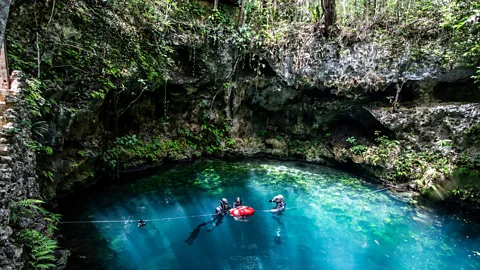 Alex St-Jean
Alex St-JeanA remarkable history
The Yucatan Peninsula is almost completely composed of porous limestone – picture a hard and holey piece of Swiss cheese made of calcareous rock. More than 65 million years ago, it was completely submerged under the sea as part of a coral reef system. The Chicxulub asteroid impact shifted the underlying tectonic plates and lifted the reef out of the water. Over millions of years, rain and seawater carved its way through the bedrock to create aquifers just metres below the ground. When the ground collapses and creates a sinkhole, as it does quite often in the Yucatan Peninsula, it sometimes exposes these aquifers in the form of natural pools, or cenotes (from the Mayan word ts'ono'ot, which means "hole filled with water"). The region's unprecedented and singular history gained it Unesco World Heritage tentative listing in 2012.
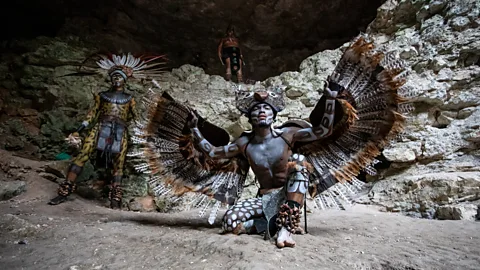 Alex St-Jean
Alex St-JeanAn ancestral Maya legacy
To enter a cenote is to enter the underworld: Xibalba. According to Maya belief, one must first ask permission and perform rituals to safely enter. Offerings must be made, and many years ago these took the form of gold, jade, copper and or even live humans. These offerings were made to appease gods such as Chaac, the rain god who the Maya believe dwells within cenotes.
These days, offerings consist mainly of copal (tree resin), cacao, seeds, corn, flower petals, sugar and other small objects. Tourists can book cultural tours to watch rituals and performances at various cenotes – without fear of being sacrificed, of course.
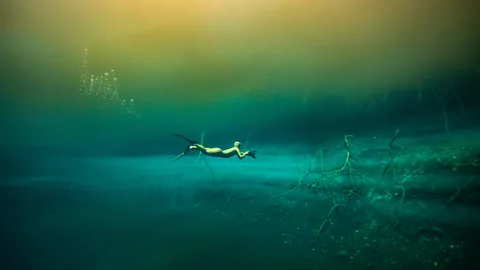 Alex St-Jean
Alex St-JeanExploring cenotes through freediving
Most travellers who visit cenotes will spend the day exploring the caves and going for a swim. Putting on a mask or goggles will allow you to see a variety of small fish, turtles, crocodiles and interesting rock formations just below the surface. But this is just the tip of the iceberg. The deeper you go, the more you see.
When freediving, you hold your breath and dive down to a specified depth without the use of an air source. It requires deep concentration as well as awareness of oneself and the environment, and allows you to immerse yourself completely in a cenote in the least disruptive way possible. You'll find stalagmites and stalactites that date back millions of years, jumbles of fallen trees and debris, fossils of extinct animals, underwater creatures that exist nowhere else on Earth and countless other fascinating features. Travellers can book freediving sessions with the many schools and outfitters in the region.
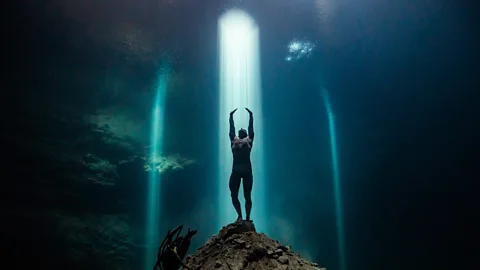 Alex St-Jean
Alex St-JeanA one-of-a-kind landscape
Sunlight filters in through holes in the roofs of cenotes and focuses them into distinct beams, a natural phenomenon found in very few other places. Seeing these light beams inspires an otherworldly sense of awe and wonder. They also make for unique photo opportunities, a trend that is on the rise as more and more people explore the vast underwater landscape of Mexico's cenotes.
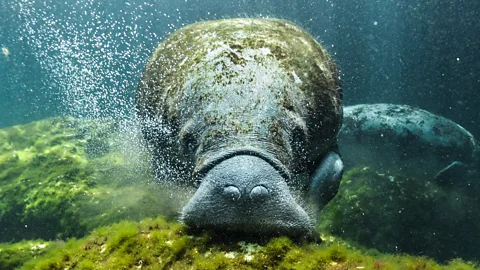 Alex St-Jean
Alex St-JeanA safe haven for fauna
Many species depend upon cenotes as a place to relax and replenish. Isolated from the open ocean, these sinkholes provide a sanctuary from harsh weather conditions, waves, large predators and boat traffic. Manatees make their way into cenotes via caves that are connected to the Caribbean Sea. Here, the endangered species can rest, fill up on algae and even nurse their young in a safe and peaceful environment.
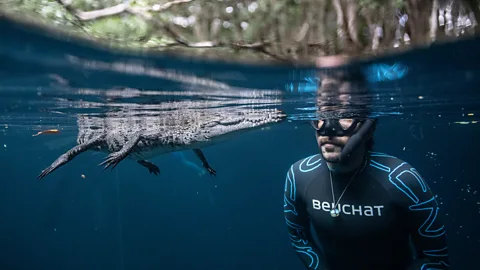 Alex St-Jean
Alex St-JeanUp close and personal
The interactions between freedivers and marine life in the cenotes are one-of-a-kind experiences. Crocodiles are a vital part of the region's biodiversity. They can be found in many cenotes, even the ones that tourists frequent. It is important to respect the animals' space, so keeping a safe distance and not provoking them is of utmost importance. Sometimes, however, their curiosity gets the better of them and they'll come to have a peek at what the peculiar humans are doing.
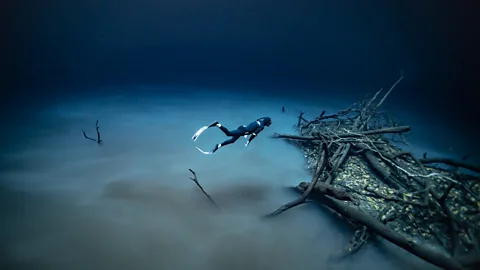 Alex St-Jean
Alex St-JeanEerily magical landscapes
In some cenotes, you'll find a layer of hydrogen sulphide that separates freshwater from cumulative rainfall from salty ocean water, essentially forming an underwater cloud. Swimming around and into these clouds gives the distinct impression of cruising through space and weaving through nebulae.
More like this:
• The buried secrets of the deadliest location on Earth
• The Train Maya: Mexico's ambitious new tourism megaproject
The layers are formed by gases released by decomposing matter such as trees and leaves that fall into the sinkholes. Some clouds are formed near the surface at a depth of a just few metres, while others can be found up to 30m deep. These thick, nebulous layers smell slightly of rotten eggs and are known to lightly sting your lips if you stay in them too long. The cloud pictured above is at a depth of about 28m and below it lies another 28m of saltwater.
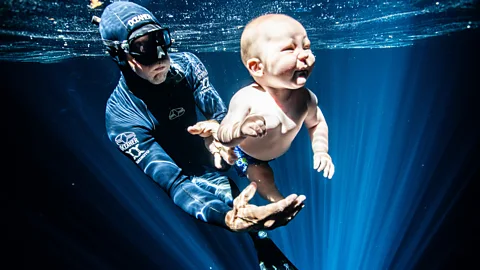 Alex St-Jean
Alex St-JeanA place for all to enjoy
People of all ages and backgrounds travel to explore Mexico's magnificent cenotes. The water temperature ranges from 19-24C, making them a welcome respite from the tropical heat. Many cenote owners have invested in infrastructure such as platforms, toilets and eateries, as well as offering guided tours and performances. With thousands of different cenotes to choose from, you will never run out of new locations to explore.
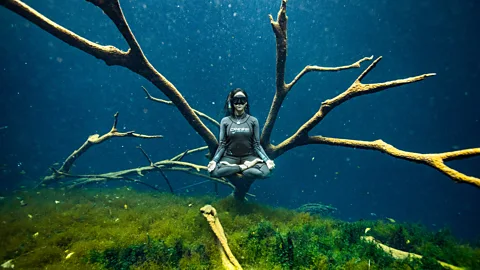 Alex St-Jean
Alex St-JeanFinding peace and balance
Living in harmony with ourselves and our surroundings is something many of us strive to achieve. Freediving requires a tremendous amount of understanding of both the mind and the world around us so it's no wonder that freedivers are passionate about these delicate ecosystems. Cenotes provide an unparalleled realm in which to go deeper, both physically and mentally, in a natural and peaceful setting.
To preserve these special places, it is essential that they are protected from contamination and over development. Some freedivers are stepping in and standing up against major forces, such as the Maya Train system, that are doing immense damage to the interconnected system of thousands of cenotes. Tourists can also help reduce any harm done to cenotes by choosing sustainable eco-tourism operators and refraining from wearing harmful sunblock and hair products.
BBC Travel's In Pictures is a series that highlights stunning images from around the globe.
--
If you liked this story, sign up for The Essential List newsletter – a handpicked selection of features, videos and can't-miss news, delivered to your inbox twice a week.
